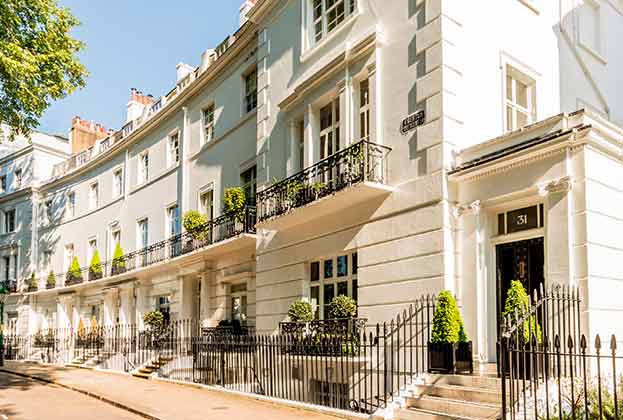Property and finance expert Anne Ashworth examines the state of the prime central London market in conversation with five of our agents
The prime central London property market has been altered by the events of 2020. Anne Ashworth sits down with five Savills agents to discuss the current state of the market, how the role of an estate agent is changing and their predictions on what comes next.
Anne Ashworth is an award-winning property and finance writer, commentator and consultant. While at The Times, she edited both Bricks & Mortar, covering property and interiors, and Times Money, the personal finance section. On 10 November, Anne hosted the Savills webinar In focus: Prime central London’s property market, where she discussed what’s next for luxury residential property and moderated a discussion with our panel of experts, all of whom are featured here.
Alex Christian
Director, Private Office
At the start of this year, we had an extraordinary number of enquiries, sparked by the election result in December of 2019. This was after a challenging period that began in 2014 when stamp duty was raised.
Recent months have been more difficult. International buyers have been unable or reluctant to travel. However, London’s fundamentals remain good, given the conflict elsewhere in the world. Over the past couple of decades, the quality and diversity of the properties here has improved. Once you would go inside a beautiful period home and it would often be in a poor state of decoration. Now the British are global leaders in interior design.
Despite its challenges, it’s been a pretty good year. It’s been a time when knowledge really counts. As an agent it is imperative to know where to start hunting for houses that are not for sale but could be available. However, if someone wants to sell their peerless house and move to something of equal calibre, it can be difficult to find such a property. There is a real scarcity of proper mansions.
Our expertise lies in guiding a person to the place where they actually want to live, even though this may not be where they begin their search. For example, people love the idea of Mayfair – a marvellous neighbourhood, but not the place where you’ll find a low-built house with a garden and parking. For those things, you need to go to Notting Hill or St John’s Wood.
If you are selling in one of those areas or anywhere else, I would say that this is the time to be nimble in your thinking. You have to be prepared to look at every offer on its merits.
Peter Bevan
Director, Kensington
One of the things I enjoy most about my job in this rarefied bit of London is meeting interesting, successful people and putting them into a house where they really want to live. And over the past few months, things have been busier than you might expect in Kensington and Notting Hill. We’ve been selling houses, not pied-à-terres, to people who fly in and out of London. Bigger flats with no outdoor space have tended to be harder to sell. But a lot of wealthier families – where the parents work in finance or private equity – emerged from the first lockdown with a sense of carpe diem. They wanted to upgrade to larger properties in neighbourhoods that are not only near green spaces such as Kensington Gardens and Holland Park, but also have a strong community spirit.
A lot of wealthier families emerged from the first lockdown with a sense of carpe diem
Peter Bevan, Director, Kensington
Some people may have decamped to the country for larger gardens and more space, but others have realised they are wedded to London. Once your children are in school, it’s far from easy to unpick your life in the city. It can be as difficult to get your children into the best schools in Oxford, for example, as it is in the capital. Added to which, it may be harder to break into the social circles that have been long established in the country.
The demand is highest for best-in-class properties. In early November, several properties near to schools went to sealed bids, with local families competing with each other. But, this has been the exception rather than the rule, meaning you should still adopt a relatively sober pricing strategy to find a buyer.
Isabella Birch Reynardson
Head of Super Prime Lettings
Dealing with the pent-up demand created by the first lockdown has demonstrated how resilient the prime central London lettings market is. But things are changing; gone are the days when companies rented properties for their senior executives. Instead, our clients are looking for homes for themselves. Often they’re tech company bosses – a surprising number run gaming businesses – and they are younger than before. Over the past two years, the average age of a tenant seeking a £4,000-a-week-plus super prime rental has fallen from 55 to 46.
The city lights are a solace during dark winter nights
Isabella Birch Reynardson, Head of Super Prime Lettings
They have considerable choice at present, thanks to strong stock levels. High-calibre homes, previously rarely available, are now more commonly on the market. Some people have been moving out to the country, sensing the first lockdown would be followed by more such periods. But others are keen to secure larger, longer-term rentals in London. For them, the city lights are a solace during dark winter nights.
At the moment we’re working closely with our landlord clients, helping them to be competitive by advising which projects provide the best return on investment. I believe in ‘branding’; styling a home and creating just the right atmosphere. This ensures prospective tenants can imagine themselves living in a place for a long time.
What I love about the prime central London world is how unexpectedly close—knit it is, despite the discretion that covers transactions. Our landlords and tenants often know each other through friends, family or colleagues, or go on to rent out properties to each other in other parts of the world.
Richard Gutteridge
Director, Prime Central London
No two days are ever the same in this job. We’ve always had to be on our toes. But now, more than ever, we have to keep evolving, to be one step in front of every type of change. Take virtual viewings, for example – who could have predicted how important they’d become, and how quickly?
This evolution is going to continue and to keep ahead, we have to predict where the market could be going next. Despite all of the uncertainties of this year, there has been a market in prime central London. Our experience is that buyers and sellers have become increasingly motivated to act. With the prospect of the market gathering further momentum next year, it’s important for our clients to have a plan and it is our job to help them formulate it. This period is an opportunity to define what the role of an estate agent should be.
This period is an opportunity to define what the role of an estate agent should be
Richard Gutteridge, Director, Prime Central London
At present, we have to help our clients towards understanding what kind of lifestyle they want now and in the future; to help them grasp what their dreams and aspirations are. They want more than simply pictures of great-looking properties. Part of the life of an estate agent is to be a psychologist and counsellor, after all. But this support and advice is backed up by research and even more analysis than before. It is a total privilege to see inside some of the finest properties in the world, and it is the greatest compliment that an owner of such a home trusts us to deal with this valuable investment. We have to be respectful of that trust.
Edward Lewis
Head of London Residential Development Sales
What I’ve been excited about over past months is how London’s villages and their high streets have been revitalised, gaining more of a community feel after the first lockdown. Before the second lockdown, local shops were doing brilliantly, thanks in large part to people working from home who have been using these places more.
London’s villages and their high streets have been revitalised
Edward Lewis, Head of London Residential Development Sales
This feels like more than just a flash in the pan. However, this happened less in the centre of town, where the population is more international. This year, those international buyers have been happy to buy off-plan up to £1 million, but they’re not going to be buying more expensive homes remotely despite the value on offer. That is only likely to change once international travel restrictions are eased, and then it could change quite quickly.
But the trend I have noticed in prime central London is the shift in the balance from Knightsbridge to Mayfair. The latter has a more subtle, established atmosphere with incredible restaurants and smart developments like the apartment schemes in Grosvenor Square by Finchatton and Lodha.
The demand for more green space and more room to work from home will influence which developments are successful. A scheme is going to need more outdoor space and a clubhouse that’s also a business centre, with great broadband and an office vibe. You may not be able to mingle with your own colleagues, but you can meet other like-minded people. This kind of facility is really useful for people living alone or sharing smaller flats. For developers, it’s a great opportunity.
.jpg)
Read the other articles within In focus: prime central London below
.jpg)

